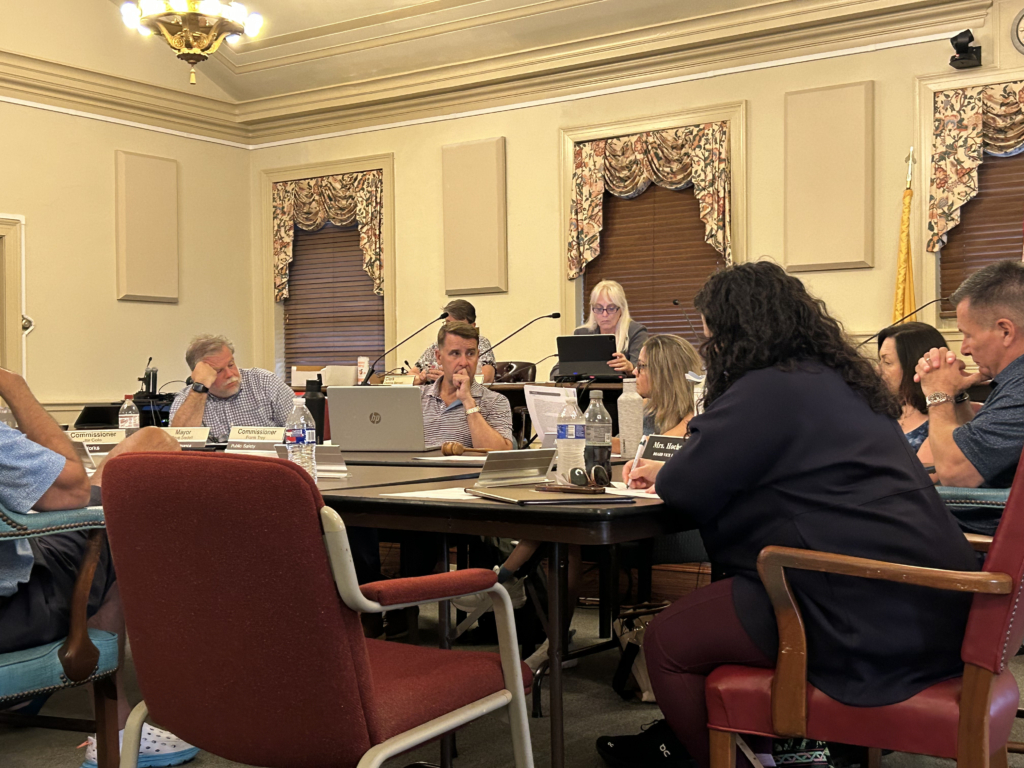
Mayor Dave Siedell (left), Commissioner Frank Troy and board of education President Jaime Grookett discuss the proposed PILOT program with Woodmont on the Bancroft property.
The board of commissioners and the Haddonfield board of education held a joint meeting on Aug. 12 to discuss the development of the Woodmont project on the Bancroft property and the proposed PILOT program associated with it.
The meeting concluded with both boards agreeing to create a separate agreement between the two that will be independent of the PILOT program by June 30, 2026. The last joint meeting called to address the Bancroft property took place in 2011, making this month’s session rare.
The commissioners used the meeting to re-explain what the proposed PILOT program will entail, with the 30-year project beginning when the Woodmont properties first receive a certificate of occupancy. Until then, the property will be taxed as land.
“It is taxed as land until it has a certificate of occupancy correct, and then it switches to the PILOT,” explained Mayor Dave Siedell. “So if they just did nothing, we’d be charging the land value, and they would still have to pay taxes, but they’re not going to do that.
“They’re going to move as quickly as possible to get the PILOT, and that’s the incentive.”
The borough will receive 10% of the annual gross revenue from years one to 10 of the program, then 11% in years 11 to 15 and 12% in years 16 to 20. This program is projected to result in $18 million for the borough.
In the last decade of the program, there are stepped increases and a clause that will require Woodmont to pay whichever is greater, the conventional property tax or the PILOT payments. That clause kicks in at year 16 of the program.
Siedell also pointed out that unlike other municipalities in the state that have utilized PILOTs, Haddonfield’s situation is unique due to it beginning the project with $20 million in prior costs. The expenses come from the legal battles over what should be done with the Bancroft property, demolition costs for its previous buildings and costs associated with acquiring it.
“Taxpayer money from 2008 through 2024 has gone into … buying off the builder, demoing the buildings that were promised to be demoed by the builder, and then all the lawsuits,” the mayor pointed out. “So instead of starting at zero, we’re starting at $20 million in the hole as a community, so that’s the reality of the money on both sides.”
The meeting also addressed the board of ed’s concerns regarding the potential student population growth from the affordable- and luxury-housing units planned on the site by Woodmont and the resulting financial burden on the school district.
Board President Jaime Grookett also brought up the issue of having to choose between making cuts and raising taxes, a situation further complicated by New Jersey’s mandated levy cap of 2%.
“Our budget is created based on the full amount we’re going to get,” Grookett emphasized. “So it’s not as though we’re creating a budget and we’re saying these are all the things we need, and you’re going to fulfill that …
“The way it works is we have a number to which we have to cut in order to make it so we don’t have to cut the SRO (School Resource Officer). So we’re responsible for creating a budget that fits in that.”
The school district has projections for how many new students may result from other affordable-housing projects in the borough like The Place at Haddonfield. Current estimates say that by 2029, the school population will grow from its current number of 2,764 students to about 3,000, though the numbers do not factor in Woodmont.
Though no formal action was taken at the meeting, both parties agreed that annual reviews of student enrollment and costs associated with it will be conducted and that several solutions to the board’s concerns will be considered, including direct financial support to the district or capital investments to offset expenses.
